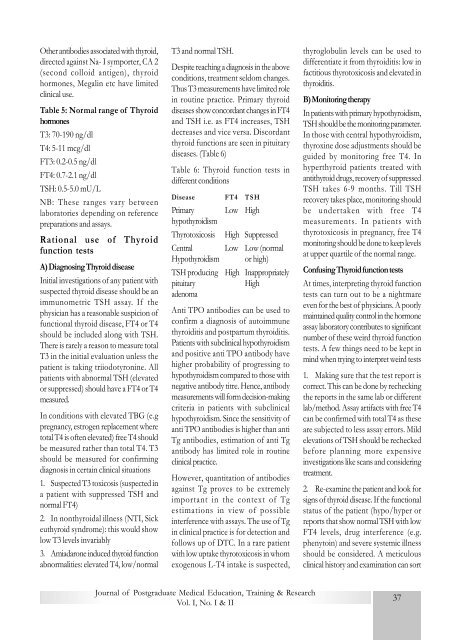Journal 1pages FINAL 34- - National Board Of Examination
Journal 1pages FINAL 34- - National Board Of Examination
Journal 1pages FINAL 34- - National Board Of Examination
You also want an ePaper? Increase the reach of your titles
YUMPU automatically turns print PDFs into web optimized ePapers that Google loves.
Other antibodies associated with thyroid,directed against Na- I symporter, CA 2(second colloid antigen), thyroidhormones, Megalin etc have limitedclinical use.Table 5: Normal range of ThyroidhormonesT3: 70-190 ng/dlT4: 5-11 mcg/dlFT3: 0.2-0.5 ng/dlFT4: 0.7-2.1 ng/dlTSH: 0.5-5.0 mU/LNB: These ranges vary betweenlaboratories depending on referencepreparations and assays.Rational use of Thyroidfunction testsA) Diagnosing Thyroid diseaseInitial investigations of any patient withsuspected thyroid disease should be animmunometric TSH assay. If thephysician has a reasonable suspicion offunctional thyroid disease, FT4 or T4should be included along with TSH.There is rarely a reason to measure totalT3 in the initial evaluation unless thepatient is taking triiodotyronine. Allpatients with abnormal TSH (elevatedor suppressed) should have a FT4 or T4measured.In conditions with elevated TBG (e.gpregnancy, estrogen replacement wheretotal T4 is often elevated) free T4 shouldbe measured rather than total T4. T3should be measured for confirmingdiagnosis in certain clinical situations1. Suspected T3 toxicosis (suspected ina patient with suppressed TSH andnormal FT4)2. In nonthyroidal illness (NTI, Sickeuthyroid syndrome): this would showlow T3 levels invariably3. Amiadarone induced thyroid functionabnormalities: elevated T4, low/normalT3 and normal TSH.Despite reaching a diagnosis in the aboveconditions, treatment seldom changes.Thus T3 measurements have limited rolein routine practice. Primary thyroiddiseases show concordant changes in FT4and TSH i.e. as FT4 increases, TSHdecreases and vice versa. Discordantthyroid functions are seen in pituitarydiseases. (Table 6)Table 6: Thyroid function tests indifferent conditionsDisease FT4 TSHPrimary Low HighhypothyroidismThyrotoxicosis High SuppressedCentral Low Low (normalHypothyroidism or high)TSH producing High InappropriatelypituitaryHighadenomaAnti TPO antibodies can be used toconfirm a diagnosis of autoimmunethyroiditis and postpartum thyroiditis.Patients with subclinical hypothyroidismand positive anti TPO antibody havehigher probability of progressing tohypothyroidism compared to those withnegative antibody titre. Hence, antibodymeasurements will form decision-makingcriteria in patients with subclinicalhypothyroidism. Since the sensitivity ofanti TPO antibodies is higher than antiTg antibodies, estimation of anti Tgantibody has limited role in routineclinical practice.However, quantitation of antibodiesagainst Tg proves to be extremelyimportant in the context of Tgestimations in view of possibleinterference with assays. The use of Tgin clinical practice is for detection andfollows up of DTC. In a rare patientwith low uptake thyrotoxicosis in whomexogenous L-T4 intake is suspected,thyroglobulin levels can be used todifferentiate it from thyroiditis: low infactitious thyrotoxicosis and elevated inthyroiditis.B) Monitoring therapyIn patients with primary hypothyroidism,TSH should be the monitoring parameter.In those with central hypothyroidism,thyroxine dose adjustments should beguided by monitoring free T4. Inhyperthyroid patients treated withantithyroid drugs, recovery of suppressedTSH takes 6-9 months. Till TSHrecovery takes place, monitoring shouldbe undertaken with free T4measurements. In patients withthyrotoxicosis in pregnancy, free T4monitoring should be done to keep levelsat upper quartile of the normal range.Confusing Thyroid function testsAt times, interpreting thyroid functiontests can turn out to be a nightmareeven for the best of physicians. A poorlymaintained quality control in the hormoneassay laboratory contributes to significantnumber of these weird thyroid functiontests. A few things need to be kept inmind when trying to interpret weird tests1. Making sure that the test report iscorrect. This can be done by recheckingthe reports in the same lab or differentlab/method. Assay artifacts with free T4can be confirmed with total T4 as theseare subjected to less assay errors. Mildelevations of TSH should be recheckedbefore planning more expensiveinvestigations like scans and consideringtreatment.2. Re-examine the patient and look forsigns of thyroid disease. If the functionalstatus of the patient (hypo/hyper orreports that show normal TSH with lowFT4 levels, drug interference (e.g.phenytoin) and severe systemic illnessshould be considered. A meticulousclinical history and examination can sort<strong>Journal</strong> of Postgraduate Medical Education, Training & ResearchVol. I, No. I & II37
















